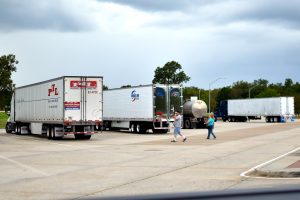Every year, the American Transportation Research Institute (ATRI) releases a survey that identifies the U.S. trucking industry ‘s most pressing issues, in addition to strategies on how to deal with these dilemmas. Listed below are 10 of the most pressing issues, according to ATRI:
1. Hours-of-Service (HOS)
No surprise here: Hours of service have been on the radar of most, if not all, truck drivers in the U.S. for some time now. ATRI says the 34-hour restart provisions could have something to do with it, since 80 percent of motor carriers suffered a loss of productivity due to the regulation. The rule was eventually suspended in December 2014, but the impact on drivers’ pay was in the billions of dollars.
Suggested strategies to the HOS dilemma include pushing for the restart regulation to remain suspended until such time as the “direct economic and safety impacts of the rules are properly quantified,” per ATRI, which also suggests looking into the safety and economic repercussions of driver delays at customer facilities. And lastly, truckers probably wouldn’t mind more flexibility on the sleeper berth provision, which states: “Drivers must take at least eight consecutive hours in the sleeper berth, plus a separate two consecutive hours either in the sleeper berth, off duty, or any combination of the two.”
2. Compliance, Safety, Accountability (CSA)
CSA is an initiative of the Federal Motor Carrier Safety Administration (FMCSA) meant to improve commercial motor vehicle safety and, in so doing, reduce crashes, injuries and fatalities that result from big trucks and buses. This issue has been bumped up one position from 2014. CSA’s safety measures are known as the seven Behavioral Analysis and Safety Improvement Categories (BASICs), and include unsafe driving, HOS compliance, vehicle maintenance, driver fitness, controlled substances and alcohol, hazardous materials compliance, and crash indicator
Enjoying our insights?
Subscribe to our newsletter to keep up with the latest industry trends and developments.
Stay InformedIf CSA removed crash types that could not be prevented (such as being hit by a drunk driver or by another vehicle when legally parked) from carrier scores, in addition to altering the way in which it determines accountability of said crashes, it would improve how safety performance is measured, according to ATRI.
Overall, the inclusion of CSA scores as part of the proposed rule-making on Safety Fitness Determination has already raised a few eyebrows. Inconsistencies have been spotted in the way states gather and report safety data performance and, says ATRI, “shippers are potentially misusing the data in the selection of carriers to haul freight.”
3. Driver Shortage
A new report by the American Trucking Associations (ATA) claims that driver shortage is up 30 percent compared to 2014. The industry needs about 48,000 more operators this year, a number that could go up to 175,000 by 2024. Reasons for the shortage include low wages, lack of industry interest, truck-driving lifestyle, new driver regulations, and the current driver demographic: As much as 26 percent of the industry’s workforce are baby boomers aged 55 and older — and they’re aging.
A “graduated” CDL (commercial driver’s license) program that would entice both new and younger drivers (including those aged 18 to 20) is one possible solution suggested by ATRI. Another is to conduct research and quantify recruitment strategies that have proven to be successful.
4. Driver Retention
Finding qualified – let alone experienced — drivers is one issue, but actually keeping them is a whole other ballgame. According to ATRI’s review, turnover rates are still notably higher than those of a number of other sectors of the U.S. workforce. And the results are impacting motor carriers on a monetary level, as they must pay more for recruitment and training, especially since their efforts are being placed on vehicle operators with top-notch productivity and safety qualifications.
Taking a closer look at the correlation between driver productivity and driver compensation will be important, as will understanding and publishing key factors that help improve their work-life balance, family relationships and health. The increased frequency of home time, in addition to the provision of newer equipment to truckers, is considered to be a successful strategy among carrier best practices.
5. Truck Parking
The ongoing and increasing national shortage of available truck parking can create dangerous situations for vehicle operators, forcing them to drive beyond the mandatory HOS down time in search of a location to park their rig. As a result, the spot they choose may be in a non-designated or unsafe area, and that can spell trouble for the trucker.
Case in point: The driving force behind the Federal Highway Administration’s report, “Jason’s Law Truck Parking Survey Results and Comparative Analysis,” was the murder of a trucker in a location that was thought to be safe.
One of the more obvious solutions to this dilemma is the investment in new parking facilities. In addition, ATRI suggests informing state and local officials about the above-mentioned consequences of closing public parking areas.
6. Electronic Logging Device (ELD) Mandate
Although the Federal Motor Carrier Safety Administration has released a report stating the safety benefits of electronic hours-of-service recorders, industry stakeholders pointed out several concerns with the proposed ELD rule.
The regulation will require that all truckers with a CDL (and who have to keep a Record of Duty Status, or RODS) must use an ELD to keep tabs on their HOS. However, it will be important that the new mandate does not require devices to create paper printouts of HOS records, so as to ensure that early adopters of the technology are not forced into replacing their devices before they’ve become outdated.
ATRI also suggests a guarantee that the two-year implementation window remains just that — two years — as an extension can create unfair advantages for certain competitors.
7. Driver Health/Wellness
There is a positive relationship between driver health and driver safety, according to industry research. The fact that this issue placed seventh (the highest ranking it has reached since 2012) implies that changes need to be made. More healthful food options and an increased availability of exercise facilities could help improve the issue, and everyone would benefit.
How? Aside from the positive impact it would have on the actual truck driver, ATRI says there is an important connection between vehicle operators’ health and the U.S. trucking industry’s ability to hold onto qualified drivers.
That being said, if companies are to create wellness programs for their drivers, ATRI says they need to see quantifiable data of the potential return-on-investment, which means more research is needed.
8. Economy
Once a prime concern during the Great Recession, the subject of the economy has since dropped to the near-end of ATRI’s list. There is, however, the matter of the European and Asian economies, and the consequences that a strong U.S. dollar is having on exports. According to Forbes, “A rising dollar relative to the currencies of our trading partners generally makes our imports cheaper to our consumers and our exports more expensive to foreign buyers.”
The number-one proposed strategy, based on ATRI’s research, is regulatory reform to help the economy: getting rid of rules that are ineffective, burdensome, and that end up costing the industry more money without providing any benefits.
9. Transportation/Infrastructure/Congestion/Funding

ATRI’s number-one strategy? The advocacy of long-term highway funding via some form of user fees, such as an increased fuel tax. More than half of a recent study’s respondents voted for this solution, along with the prevention of “additional diversion of revenue to non-highway projects.”
10. Driver Distraction
For the second consecutive year, driver distraction has made the list, and here’s why: With the increased incorporation of new technology on all vehicles comes more concern.
To be clear, National Highway Traffic Safety Administration (NHTSA) says distraction is “anything that takes your eyes off the road (visual distraction), your mind off the road (cognitive distraction), or your hands off the wheel (manual distraction).” Among the technologies that could divert one’s attention (such as the touchscreen display in your vehicle), texting and cell phone use appear to be a prime example of this issue. In most states, texting while driving is banned, and in some areas, hand-held devices are also prohibited.
To help deal with this dilemma, ATRI suggests encouraging stricter penalties, and a tougher enforcement of them when motorists violate any distracted-driving regulation.
(from Trucks.com)

























